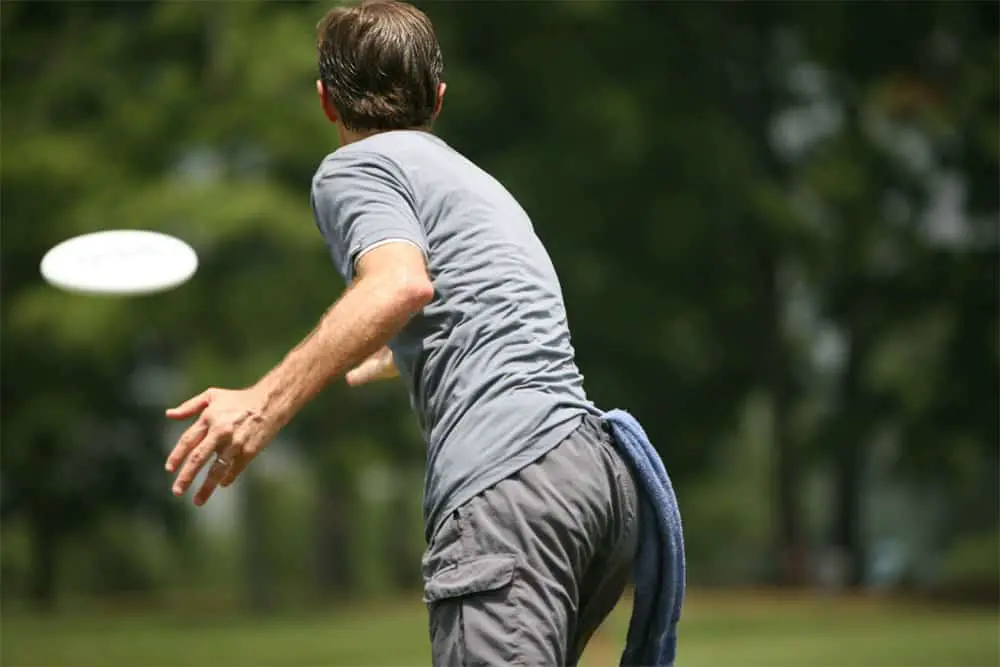One of the big traps beginner disc golf players fall into is throwing too hard. It’s an issue that begins with a lack of understanding in how the disc works, and how to get the best out of it, as well as inconsistent technique and a poor understanding of the game itself.
Discs that are thrown too fast and with poor technique are prone to turning over or flipping over which is something no disc golfer wants unintentionally, however there are other outcomes too.
Discs that get lost are often never seen again because they’ve been thrown too fast and have gone way out of bounds.
Another issue is that discs going too fast can get damaged if they come into contact with obstacles.

Discs can also pull in different directions if thrown too hard, and much like in traditional golf, this type of drawing and pulling can set you up for a huge failure.
There are a few different things that can make players overcook their throws, and they come in a few different categories.
Losing Strength And Becoming Tired
Naturally, as players start to feel themselves tiring, they begin to try and overcompensate.
This problem will often strike beginners who are new to the game and don’t understand how taxing it can be, however even tournament players can suffer if they’ve strained themselves in the first half of the game and are running out of energy towards the last few rounds.
The best players eliminate this problem by ensuring their fitness is high and only using the required amount of power each time. Trying to fully send a disc the full distance with each shot on every hole will inevitably come back to bite players later on.
Trying To Increase The Distance Of Your Standard Distance Shot
Players who are under pressure or struggling to play well will often try to increase the distance of their first shot in order to try and improve their game and close the gap on their opponents.
In disc golf, distance shots need to be consistent in order to maintain any semblance of accuracy and technique, and trying to increase the distance and power of your shot will likely have a drastic impact on the actual quality of the shot itself.
Players often feel like they could squeeze a little more out of their distance shot, but the problem with this is that it is often a case of diminishing returns.
It’s much better to hit a stable and accurate distance shot at a relatively standard power and position yourself well for the following shots, than it is to squeeze a few extra yards out of the distance shot to put yourself at a huge disadvantage or go out of bounds.
This also plays into the first issue, of tiring out more quickly and compounds all these issues into one, making for a miserable day at the course.
Timing, form and technique are critical in disc golf, and abandoning your core playstyle when under pressure is a sign of a weak player who is crumbling under pressure.
Try to remain calm and stick with your standard shot style and power level, as composure will often lead to you improving over time instead of seeking a quick fix by punting it with every throw.
Respect The Disc
Discs are specially designed to be able to handle specific power levels, and not sticking to this is a great way to crash into something or missing your shot.
Discs glide very well and if you put too much speed into your shot you risk totally missing your landing area.

Try to get into the habit of choosing the right disc for the right throw, and using slightly less power and you will often see a huge improvement in your accuracy over simply throwing the disc as fast as you can.
Respect the disc, and use it properly, and it will often carry you to success.
Underestimating Your Power And The Shot
Certain holes, particularly those with a long fairway prompt players to try to go for glory right off the teepad. However this temptation often undoes most players, even at a high level as ambition overcomes everything else.
Going hard for that chance at a birdie instead of ensuring a simple par is a great way to land yourself in a tricky spot, and can often see you drop shots instead of gaining them.
It’s also possible for the opposite to occur, and for players who do manage to make a good shot to wildly overthrow the disc and to miss the basket as badly as if they’d hit a tree or gone out of bounds entirely.
Conditions
Taking into account the prevailing weather is really important in disc golf, as wind can play a huge part in both your success and the safety of the sport.
This is another issue that affects beginners more as they are less used to judging how wind will affect the disc.
If you throw too hard and get a sudden tailwind you will widely overshoot, while throwing right into a headwind can cause all kinds of unexpected issues.
Generally in windy weather it’s best to throw with control and try to get low altitude shots off to remove the risk of drifting and gliding with the wind.
Another important note about conditions is playing in wet weather. For safety reasons, no player should attempt full power shots in wet weather conditions unless they are sure they are able to get a good grip on the disc and can safely release the shot.
The implications of not taking this seriously can be potentially disastrous, as discs can reach speeds of over 100 mph and can cause a lot of damage if they hit someone, or something.